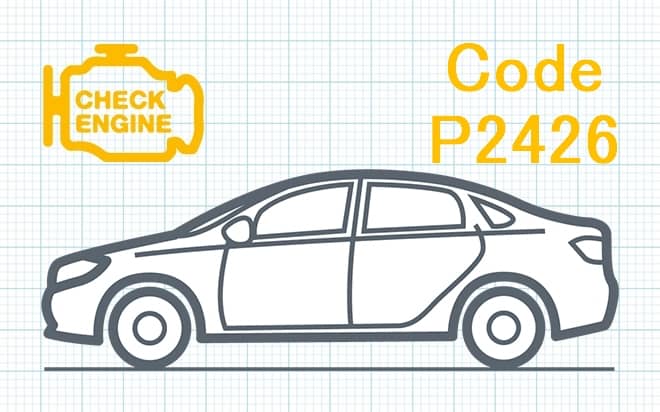
P2426 A low indicator of the control circuit of the cooling valve of the exhaust gas recirculation system
Content
- P2426 A low indicator of the control circuit of the cooling valve of the exhaust gas recirculation system
- OBD-II DTC Datasheet
- What does this mean?
- What is the severity of this DTC?
- What are some of the symptoms of the code?
- What are some of the common causes for the code?
- What are some steps to troubleshoot the P2426?
- Related DTC discussions
- Need more help with the P2426 code?
P2426 A low indicator of the control circuit of the cooling valve of the exhaust gas recirculation system
OBD-II DTC Datasheet
Low signal in the control circuit of the cooling valve of the exhaust gas recirculation system
What does this mean?
This Diagnostic Trouble Code (DTC) is a generic transmission code and applies to many OBD-II vehicles (1996 and newer). This may include, but is not limited to, VW, Nissan, Audi, Ford, etc. Despite the general nature, the exact repair steps may vary depending on the model year, make, model and transmission configuration.
A stored code P2426 means the powertrain control module (PCM) has detected an insufficient voltage in the EGR valve control circuit. EGR cooling systems are only used in diesel engines.
The EGR system is designed to deliver some of the inert exhaust gases back to the engine intake system, where it replaces oxygen-rich clean air. Replacing the exhaust gas with oxygen-rich air reduces the number of nitrogen oxide (NOx) particles. NOx is regulated by federal law and is one of the constituents of ozone-depleting exhaust gas emissions.
EGR cooling systems are used to reduce the temperature of EGR gases before they enter the engine air intake system. The EGR cooling system acts as a radiator or heater core. The engine coolant is sealed within a finned area that is positioned to allow EGR gases to pass through. A cooling fan is also sometimes used. The electronically controlled EGR cooling valve regulates the flow of engine coolant to the EGR cooler under certain conditions.
The PCM uses inputs from the engine coolant temperature (ECT) sensor and EGR cooler temperature sensor / s to determine when and to what extent the EGR cooling valve opens or closes at any given time. The PCM monitors the voltage to the EGR cooling valve control system each time the key is turned on.
The EGR cooler and EGR cooler temperature sensors inform the PCM of changes in the EGR cooler and the engine coolant temperature. The PCM compares these inputs to calculate if the EGR cooling system is working properly. Exhaust gas recirculation temperature sensors are usually located near the exhaust gas recirculation valve, while ECT sensors are usually located in the cylinder head water jacket or intake manifold water jacket.
If the EGR cooling valve control voltage is too low, below the normal programmed range, or if the inputs from the EGR temperature sensor / sensors are not similar to those from the ECT sensor, P2426 will be stored and the malfunction indicator lamp may be illuminated.
The exhaust gas recirculation valve is part of the exhaust gas recirculation system: 
What is the severity of this DTC?
A stored code P2426 refers to the EGR system. It should not be categorized as heavy.
What are some of the symptoms of the code?
Symptoms of a P2426 trouble code may include:
- No symptoms (other than storing the code)
- Increased cylinder temperature
- Reduced fuel efficiency
- Exhaust Gas Temperature Sensor Codes
- Engine temperature sensor codes
What are some of the common causes for the code?
Reasons for this code may include:
- Open or short circuit in the wiring or connectors for controlling the exhaust gas recirculation cooling valve
- Low engine coolant level
- Defective sensor / s of temperature of the exhaust gas recirculation system
- Clogged exhaust gas recirculation cooler
- Engine overheating
- Exhaust gas recirculation cooling fan defective
What are some steps to troubleshoot the P2426?
The engine cooling system must be filled to the correct level with the correct coolant before proceeding. If there are engine coolant leaks or the engine overheats, it must be repaired before continuing with the diagnosis of the stored P2426.
A diagnostic scanner, digital volt/ohmmeter, vehicle information source, and infrared thermometer (with laser pointer) are some of the tools I would use to diagnose a P2426.
I could start by visually inspecting the wiring and connectors associated with the EGR temperature sensor and the ECT sensor. Harnesses that are in close proximity to hot exhaust pipes and manifolds must be carefully checked.
Connect the scanner to the vehicle diagnostic port and get all stored codes and corresponding freeze frame data. Before clearing the codes and testing the vehicle, I would like to record this information in case it turns out to be an intermittent code.
At this time, one of two things will happen: either the PCM will go into standby mode (no codes stored), or P2426 will be cleared.
If the PCM goes into readiness any longer, the P2426 is unstable and more difficult to diagnose. In many cases, the condition must worsen before an accurate diagnosis can be made.
If P2426 is reset, use the scanner data stream to observe the EGR temperature sensor data and the ECT sensor data. Narrowing down the scanner data stream to include only the necessary information will result in a faster data response. If the scanner shows that the EGR and ECT temperatures are within acceptable parameters, suspect a faulty PCM or a PCM programming error. This is your least likely scenario.
If the EGR temperature sensor data or the coolant temperature sensor data is unstable or out of specification, test the corresponding sensor / sensors by following the test procedures and specifications provided in your vehicle information source. Sensors that do not meet the manufacturer's specifications should be considered defective.
Use the DVOM to test the EGR cooling valve control circuit if the sensors are working properly. Remember to turn off all associated controllers before testing. Repair or replace open or shorted circuits as necessary.
If all sensor circuits for the EGR valve control are intact, use an infrared thermometer to check the temperature of the exhaust gases at the inlet to the EGR cooler (valve) and at the outlet of the EGR cooler (with the engine running and at normal operating temperature). Compare the results obtained with the manufacturer's specifications and replace any faulty EGR cooling system components as necessary.
- Installing aftermarket and highly efficient exhaust gas recirculation components can result in storage of P2426.
Related DTC discussions
- There are currently no related topics in our forums. Post a new topic on the forum now.
Need more help with the P2426 code?
If you still need help with DTC P2426, post a question in the comments below this article.
NOTE. This information is provided for informational purposes only. It is not intended to be used as a repair recommendation and we are not responsible for any action you take on any vehicle. All information on this site is protected by copyright.
